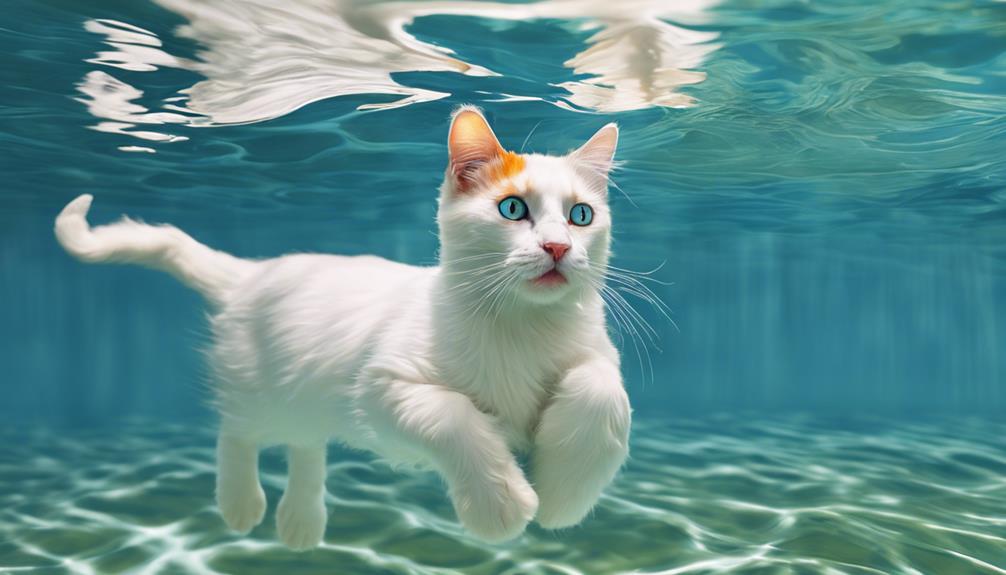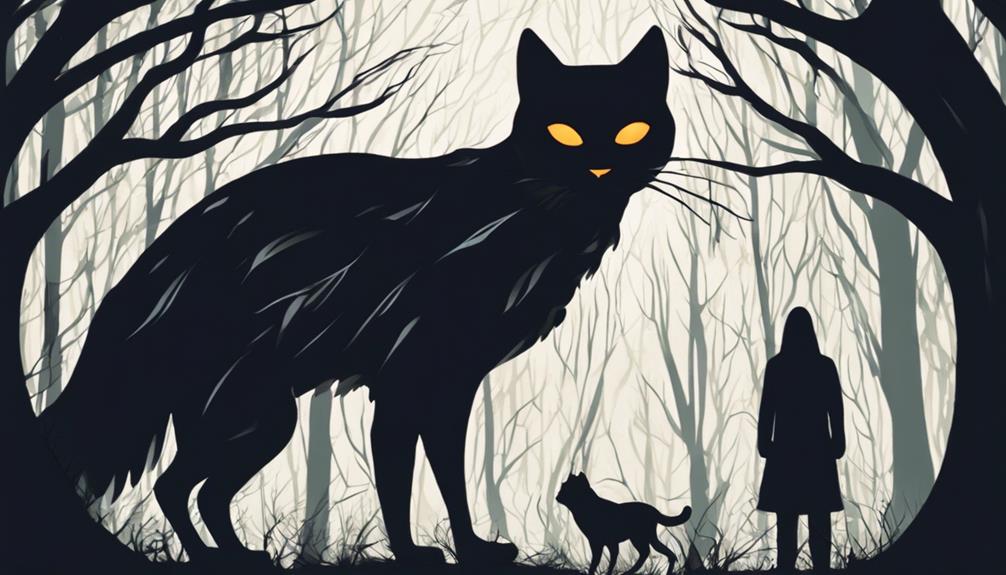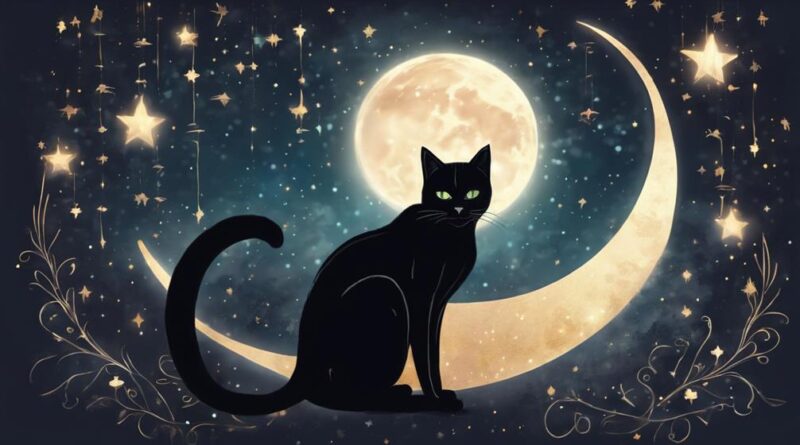Unraveling Feline Folklore: Global Cat Myths Explained
Step into a realm where cats are more than just pets; they are mystical beings intertwined with global folklore. Explore the Ancient Egyptian Goddess Bastet, symbolizing strength and grace. Discover the Japanese Maneki-Neko Lucky Cat, a talisman of good fortune. Norse mythology unveils Freyja's divine cats, bridging realms with grace. Celtic legend whispers of Cait Sidhe, mysterious fairy cats of luck or misfortune. Turkish Van Cats surprise with their swimming prowess. Russian folklore delves into Kot Bayun, a feline enigma. Unravel the spiritual significance of Indian Goddess Sasti's feline companion. There is a world of cat myths waiting to be uncovered.
Ancient Egyptian Cat Goddess Bastet
Delve into the captivating realm of Ancient Egyptian mythology with the revered feline deity Bastet. Bastet's influence in Egyptian culture was profound, representing the nurturing aspects of womanhood, protection, and fertility. This goddess was often depicted as a lioness or a woman with the head of a lioness, showcasing strength and grace in equal measure. The ancient Egyptians held Bastet in high regard, believing she could bring health, joy, and protection to their lives.
The symbolism of cats in Ancient Egypt was intertwined with Bastet's essence. Cats were revered for their grace, agility, and hunting prowess, qualities that mirrored the goddess herself. They were seen as sacred animals, embodying the protective and nurturing characteristics associated with Bastet. In Egyptian households, cats were cherished and well-cared for, with some families even mummifying their beloved feline companions to ensure their safe passage to the afterlife.
The bond between Bastet and cats was so strong that harming a cat was considered a grave offense in Ancient Egypt, punishable by death. This reverence for felines highlights the deep-rooted connection between the goddess and her sacred animal. Through Bastet's influence, cats became not only beloved companions but also symbols of divinity and protection in the rich tapestry of Ancient Egyptian mythology.
Japanese Maneki-Neko Lucky Cat
In Japanese culture, the Maneki-Neko Lucky Cat holds a significant place, known for its beckoning paw gesture and believed to bring good fortune to its owners. This iconic Japanese waving cat has a rich symbolism attached to it. The gesture of the raised paw is thought to attract wealth and prosperity, making it a popular talisman in homes and businesses.
Maneki-Neko comes in various colors, each carrying its own meaning. The most common colors are white, believed to bring purity and happiness, and gold, associated with wealth and prosperity. Additionally, the calico Maneki-Neko is said to bring good luck in different aspects of life, including love and relationships.
The variations in Maneki-Neko designs further add to its allure. Some cats hold a koban coin, representing a traditional Japanese gold coin that symbolizes wealth and good fortune. Others may carry a mallet, known as an 'Uchide no Kozuchi,' which signifies the granting of wishes.
Norse Mythology: Freyja's Cat Chariot
Have you ever heard of the fascinating Norse myth involving Freyja's Cat Chariot, a tale that intertwines feline companionship with divine symbolism and intrigue? In Norse mythology, Freyja, the goddess of love, beauty, and fertility, is often depicted with her companions, who are divine felines known for pulling her chariot across the sky. These majestic cats aren't merely ordinary animals but beings of mystical significance, symbolizing grace, agility, and the connection between the earthly and celestial realms.
Legend has it that Freyja's chariot, drawn by her divine felines, takes her on a celestial ride through the heavens, spreading light and love wherever she goes. The mythological significance of this imagery lies in the representation of cats as powerful, otherworldly creatures that serve as loyal companions to a goddess of great importance.
The concept of Freyja's Cat Chariot highlights the revered status of felines in Norse mythology, portraying them as more than just pets but as revered beings with a crucial role in the divine workings of the world. This myth serves as a testament to the deep respect and admiration that ancient Norse cultures held for cats, viewing them as mystical creatures capable of traversing between realms and aiding in the grandeur of deities like Freyja.
Celtic Fairy Cats: Cait Sidhe
Exploring the enchanting realm of Celtic folklore reveals the captivating presence of Cait Sidhe, mystical fairy cats intertwined with ancient myths and superstitions. In Celtic folklore, these shape-shifting cats are known to inhabit the fairy realm, where they're considered both enchanting and mysterious creatures. The Cait Sidhe are believed to have the ability to transform into various forms, blending seamlessly into the mystical landscapes of the fairy world.
Legends depict the Cait Sidhe as large black cats with a spot of white on their chest, roaming the countryside under the cover of night. It's said that encountering a Cait Sidhe can bring luck or misfortune, depending on how one treats them. In some tales, these fairy cats are protectors of the fairy realm, while in others, they're omens of death and darkness.
Within Celtic folklore, the presence of the Cait Sidhe serves as a reminder of the intricate relationship between the mortal world and the ethereal realm of fairies. Their mysterious nature and shape-shifting abilities add a sense of wonder and magic to the rich tapestry of Celtic mythology, making them truly mesmerizing figures in the folklore of ancient Celtic traditions.
Turkish Van Cats: Swimming Legend

Turkish Van Cats, known for their unique swimming abilities, have long been revered as a fascinating legend in the world of feline lore. These stunning cats with their elegant coats and captivating eyes possess a remarkable trait that sets them apart from other breeds – their love for water. While most cats are averse to getting wet, Turkish Vans are natural swimmers, a behavior that has puzzled experts for years.
Genetically, the Van cat breed carries a rare trait that enables them to enjoy swimming. It's believed that this distinctive characteristic stems from their ancestors, who lived in the region of Lake Van in Turkey. The Van cats' history is intertwined with the waters of Lake Van, where they'd swim to catch fish and cool off during the hot summers. This innate ability has been passed down through generations, making Turkish Vans exceptional swimmers to this day.
Despite their love for water, Turkish Van Cats still exhibit typical feline behaviors and characteristics. Their swimming prowess is just one of the many intriguing facets of this breed, adding to the allure and mystique that surrounds these enchanting creatures. So, next time you see a Turkish Van gracefully gliding through the water, take a moment to appreciate the marvel of nature and the fascinating genetics that make them such exceptional swimmers.
Chinese Cat Mythology: Li Shou
Deep within the realm of Chinese folklore lies the intriguing tale of Li Shou, a mystical figure shrouded in enigmatic cat mythology. The Li Shou legend portrays this creature as a powerful and revered feline protector, known for its ability to ward off evil spirits and bring good fortune to those it favored. As you delve into the depths of this ancient myth, you uncover the rich tapestry of beliefs that have enshrined Li Shou as a symbol of divine grace and protection in Chinese culture.
In Chinese cat mythology, Li Shou is often depicted as a majestic cat with fur as black as the midnight sky, eyes that gleam like precious jade, and a graceful demeanor that commands respect. The legend describes how Li Shou roamed the lands, watching over villages and households, ensuring harmony and prosperity prevailed. As you ponder on the significance of this feline protector, you realize the profound impact it had on the collective imagination of the Chinese people, instilling a sense of awe and reverence for the mysterious powers attributed to cats.
Through the lens of Chinese cat mythology, Li Shou emerges as a symbol of strength, wisdom, and benevolence, embodying the enduring bond between humans and their feline companions. The legend of Li Shou continues to captivate hearts and minds, reminding us of the profound connection between folklore, culture, and the eternal mystique of cats.
Russian Folklore: Kot Bayun

Within Russian folklore, the enigmatic figure of Kot Bayun emerges, captivating the imagination with its mysterious presence and intriguing tales. In Slavic folklore, Kot Bayun is a cat-like creature known for causing fear and superstitions among the people. Unlike the typical Russian cat legends that often portray cats as protectors or bringers of good luck, Kot Bayun represents the darker, more enigmatic side of feline mythology.
Legend has it that Kot Bayun is a shape-shifting creature that can transform into a cat or a black cloud, instilling fear in those who encounter it. The mysteries surrounding Kot Bayun have led to various superstitions about cats in Russian culture. Cats were often seen as magical beings with the ability to communicate with spirits or predict the future, traits that were both revered and feared by the people.
The presence of Kot Bayun in Russian folklore serves as a reminder of the complex relationship between humans and cats, blending admiration with a sense of unease. The tales of Kot Bayun continue to intrigue scholars and storytellers alike, shedding light on the rich tapestry of Russian folklore and the enduring fascination with mystical feline creatures.
Indian Cat Deity: Goddess Sasti
In the realm of Indian mythology, the revered Goddess Sasti presides as the feline deity embodying various aspects of protection and prosperity. Goddess Sasti is often depicted with a cat by her side, symbolizing her close connection to these enigmatic creatures. Cats, in Hinduism, are considered sacred animals, and Goddess Sasti plays a crucial role in this belief system.
Sacred rituals dedicated to Goddess Sasti are performed by devotees seeking her blessings for the protection of children and the well-being of families. These rituals often involve offerings of milk and food to stray cats, believed to be her earthly manifestations. The act of caring for these feline creatures is seen as a way to honor and please the goddess, ensuring her benevolence and favor.
The spiritual significance of Goddess Sasti goes beyond mere superstition, delving into the deep-rooted cultural fabric of Indian society. She's revered not only for her protective nature but also for her ability to bring good fortune and prosperity to those who worship her diligently. The connection between Goddess Sasti and cats highlights the intertwining of the divine and the earthly, emphasizing the importance of respecting all living beings as sacred manifestations of the divine.
Frequently Asked Questions
Are There Any Famous Cats in Modern Pop Culture Inspired by These Myths?
Have you ever wondered if there are any famous cats in modern pop culture inspired by myths? Cat celebrities and cultural icons have made their mark in modern folklore through pop culture adaptations.
From mysterious black cats to wise feline guides, these mythical creatures have influenced popular characters like Salem from 'Sabrina the Teenage Witch' or the Cheshire Cat from 'Alice in Wonderland.'
Their legacies continue to captivate audiences worldwide.
How Do These Cat Myths Influence Popular Beliefs and Superstitions Today?
Do cat myths still impact cultural beliefs in modern society?
Superstitions around cat behavior persist, shaping how cats are perceived today. These ancient tales have seeped into popular beliefs, influencing how people interact with felines.
From black cat superstitions to beliefs about a cat's ability to predict the weather, these myths continue to weave themselves into everyday life, reminding us of the enduring power of folklore in shaping our perspectives on these mysterious creatures.
Are There Any Rituals or Traditions Still Practiced in Relation to These Cat Myths?
Do cultural practices or folklore celebrations still maintain rituals or traditions connected to cat myths?
It's intriguing to explore how ancient beliefs manifest in modern customs.
From honoring feline deities to performing rituals for luck or protection, these traditions retain their significance in various cultures.
Delving into the continuation of these practices sheds light on the enduring power of myth and the ways it shapes our behaviors and beliefs today.
Do These Myths Have Any Impact on the Way Cats Are Viewed and Treated in Those Cultures?
Do these myths impact the way cats are viewed and treated in those cultures?
Cultural perceptions and traditional beliefs often shape attitudes towards cats. These myths may influence cat welfare by affecting how people interact with and care for felines.
Understanding the connection between folklore and modern attitudes towards cats can provide insight into the treatment of these animals in various cultures.
Are There Any Variations or Alternate Interpretations of These Cat Myths in Different Regions?
Have you ever wondered about regional interpretations of myths or the cultural variations that shape them?
It's fascinating to explore how different regions can have alternate interpretations of the same story, shedding light on the diversity of human beliefs and traditions.
When it comes to cat myths, these variations can provide valuable insights into the unique perspectives and values held by different cultures worldwide.
Conclusion
As you journey through the rich tapestry of global cat myths, you begin to unravel the intricate connections between felines and folklore. From the revered Egyptian Cat Goddess Bastet to the charming Japanese Maneki-Neko Lucky Cat, each culture's mythological tales offer a unique perspective on the mysterious nature of these enigmatic creatures.
Exploring these myths sheds light on the universal fascination and reverence for cats throughout history, revealing the enduring allure of these fascinating creatures.
